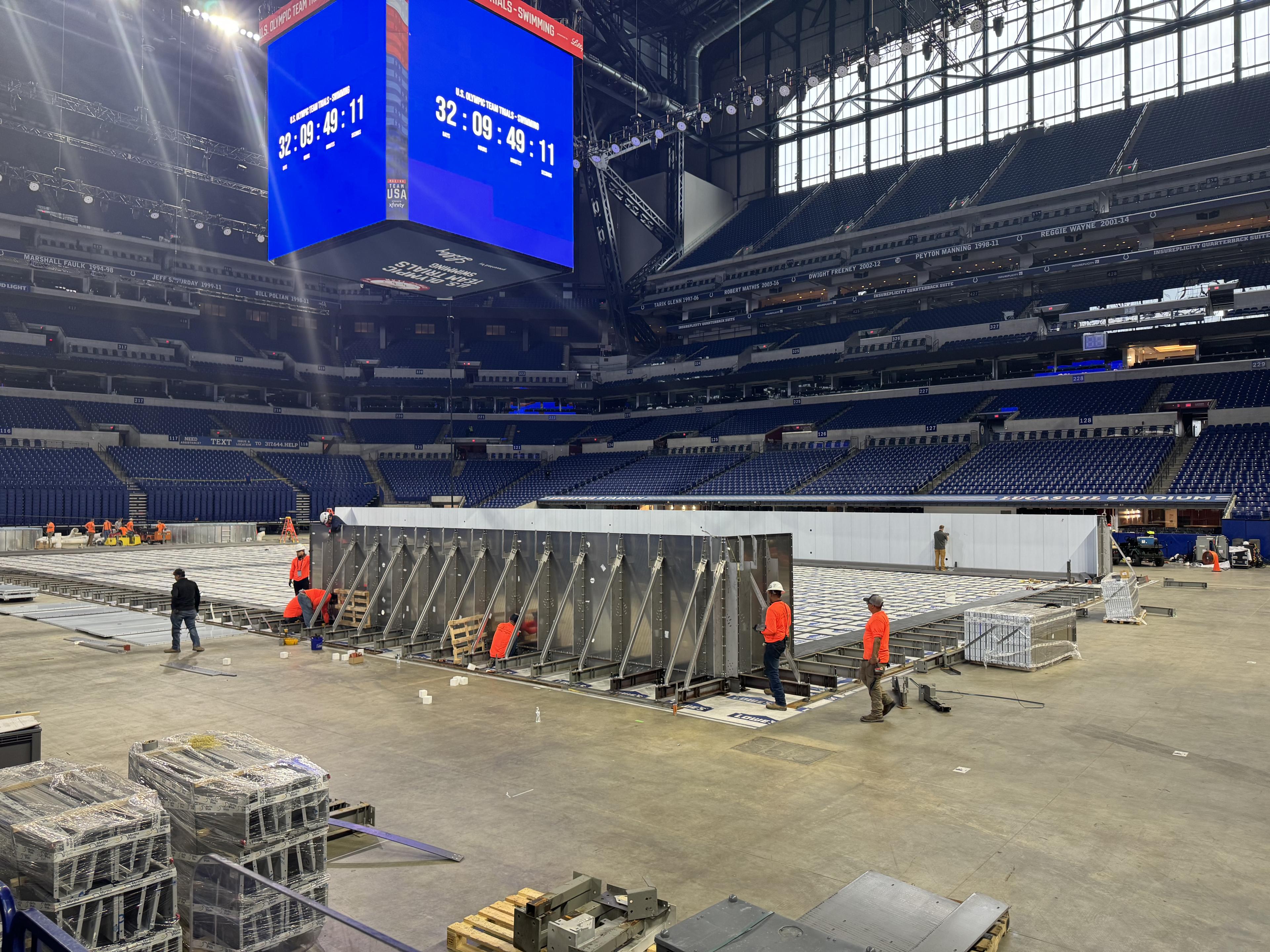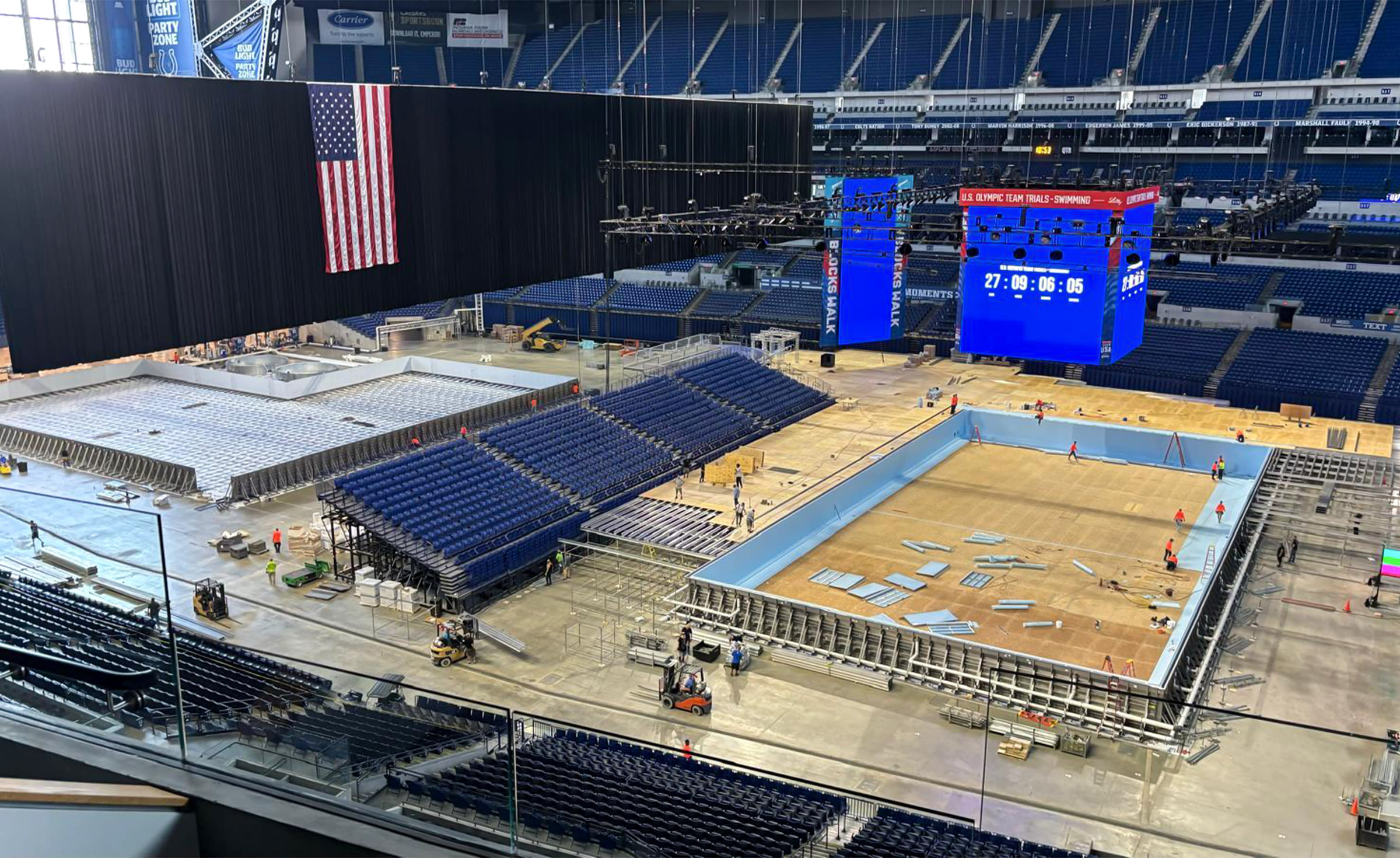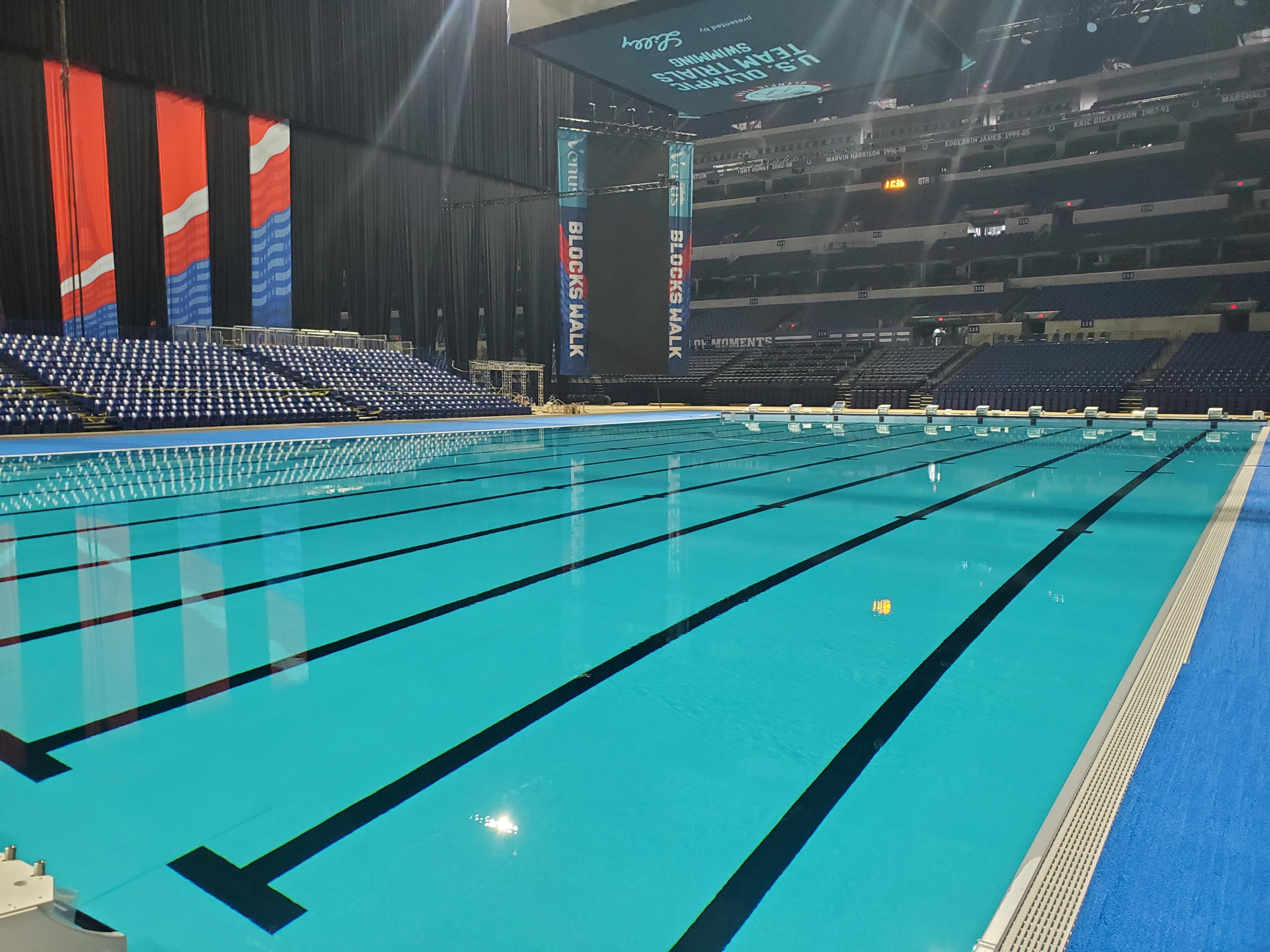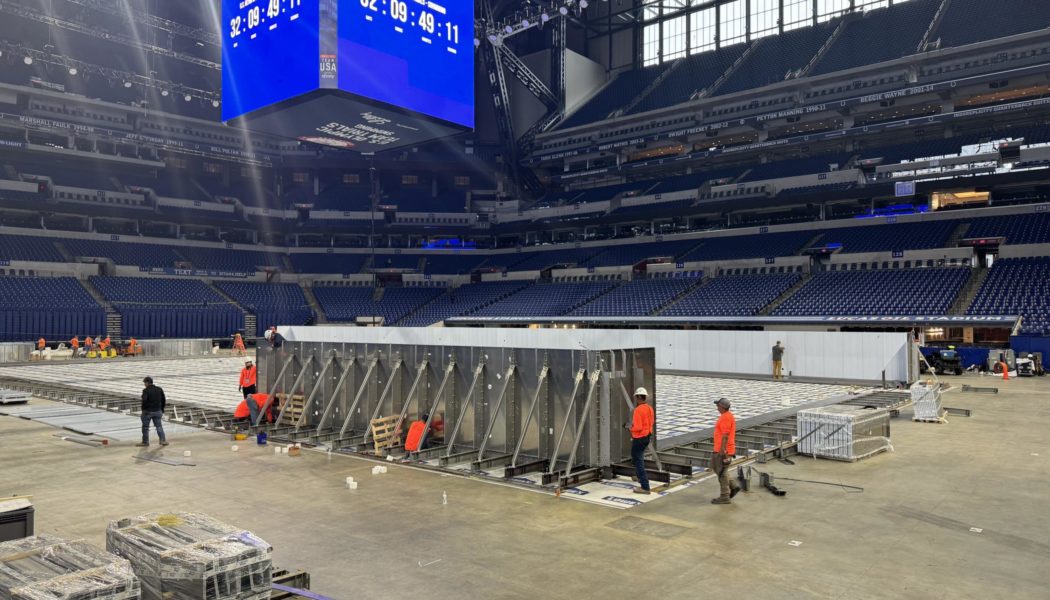The temporary pools came from northern Italy. The two million gallons of water came from a fire hydrant on South Capitol Ave., via 6,000 feet of piping that snakes through an NFL stadium. The swimmers will come from all over the United States, and step onstage near what’s usually the 45-yard line. And from June 15-23 in Indianapolis, they’ll take part in a grand, unprecedented experiment — all while trying to qualify for the Olympics.
It’s “crazy,” Bobby Finke, a 2021 gold medalist, said of the plan for this year’s U.S. Olympic swimming trials — crazy in a good way.
“It’s wild,” and “bananas,” USA Swimming chief commercial officer Shana Ferguson told Yahoo Sports last month as she surveyed the project from inside Lucas Oil Stadium.
The 70,000-seat home of the Indianapolis Colts, over the past month, has been transformed from a football field into the world’s biggest aquatic arena.
ADVERTISEMENT
Advertisement
It’s a bold, grandiose ploy to expand the reach and scale of swimming, and its execution, Ferguson says, revolved around one core question: “How in the heck are we gonna put swimming pools in a football stadium?”

An ambitious gamble
The answer came together over multiple years, and came to life over the past four weeks. Eighteen-wheelers and heavy machinery rolled into Lucas Oil. Scores and eventually hundreds of workers cycled in and out, passing stashed-away yellow goal posts on the way. They built more than an acre of pool deck some 10 feet above the stadium’s floor. The elevated “false deck,” made of “rubberized woven flooring,” allowed them to fit a 2.5-meters-deep pool without drilling into the stadium’s concrete base.
“If I drill 4,000 holes in the arena floor,” explains John Ireland, who’s overseeing construction of the pool, “they’re gonna charge me $20 million for ruining their arena.”
ADVERTISEMENT
Advertisement
To make the arrangement look semi-normal, they folded up the first 10 rows of seats. They also brought bleachers from one end zone in past midfield, and hung a giant black curtain at the 50-yard line, to divide the cavernous building in half. On the unseen half, they built a warmup pool. And on the other, they built the competition pool, the star of the show.
“They,” at this stage of the build, is Myrtha Pools, an industry-leading contractor that has supplied Olympic pools for decades. It manufactures materials, including rigid PVC and stainless steel panels, at its factory in Italy, then ships them all over the world — in this case to Indianapolis.
There, “millimetrically-perfect steel panels are bolted together and then chemically sealed in order to create a waterproof vessel,” said Ireland, the company’s director of technical services. After trials, the entire thing will be disassembled, and the parts shipped off to build permanent pools in Fort Wayne, Indiana, and the Cayman Islands.
The final integral step, then, is water. Working with the local fire department and an energy company, engineers tapped into a nearby hydrant, and pumped in some 1,200 gallons per minute. The water flowed through specially built pipes, from the concourse down over seats, to the stadium floor — which is two stories below street level.
After passing through regenerative media filters and UV-light chambers, which help with sanitation, it filled the pools. And after an Olympic team has been named, it will be pumped back out to the street.
ADVERTISEMENT
Advertisement
“I don’t think Lucas Oil would enjoy keeping two million gallons of water after this is over,” says Brian Spear, president of Spear Corporation, which is handling the plumbing and filtration. “They want it gone pretty quick.”
But first, come June 15, it will glow under laser-based spotlights, and under a 35,000-pound LED scoreboard, hung from the ceiling and installed specifically for this occasion.
The entire operation, from bells and whistles to labor, will span nearly two months and cost millions of dollars. (Officials would not provide the exact cost of the project.)
It’s a gamble, a leap from an Omaha basketball arena to a colossus, with no guarantee that the 30,000-plus seats being offered — the south half of Lucas Oil Stadium — will get snapped up. As of early June, ambitious ticket-sale goals had not yet been met.
But those, in a way, are secondary. This Olympic trials is USA Swimming’s one quadrennial chance to make a splash — on NBC, in prime time, over nine straight nights. “This is one time every four years that people are really paying attention to the sport,” Ferguson says. “So, it needs to be a bigger show. We owe it to our athletes. Not only to the athletes who are making the Olympic team, but the 6-, 7-, 8-, 9-year-old kid who might watch the Olympic trials on TV and say, ‘That’s the sport for me.’”

Bigger building, bigger opportunity
This daunting idea, of swimming in a football stadium, first brewed in or around 2018, and stemmed from a feeling that U.S. Olympic trials had “outgrown” their former home, Ferguson says.
ADVERTISEMENT
Advertisement
From 2000 to 2008, the meet had matured from an Indy natatorium to a California parking lot to the roughly 14,000-capacity arena in downtown Omaha. After four straight cycles in Omaha, with tickets selling out, USA Swimming CEO Tim Hinchey began telling colleagues: “We gotta find a bigger building.”
Their options, though, were limited. They preferred to stay indoors. But no NBA, NHL or even MLB team could offer up its venue for two months in-season.
So they chose to go big. They approached NFL stadium operators, and essentially asked: “Could we pull it off?” Once they concluded the answer was yes, they solicited bids, and chose Indy’s — which sparked buzz but also questions and concerns.
Sure, they could construct a pool, but could they make the environment feel intimate?
They also fielded a barrage of queries from swimmers and their coaches. “Oh my God, is it gonna be too big?” Ferguson remembers athletes asking. “This scares me.”
ADVERTISEMENT
Advertisement
Backstrokers wondered what they’d look at. Some Olympic hopefuls worried they’d be cold. And many shared what Ferguson calls one of several “understandable fears”: How far will I have to walk? In a stadium so sprawled, will I be exhausted by the time I reach the starting blocks?
When asked last month about the main outstanding challenges, Ferguson chuckled. “I’m only laughing,” she said, “because it feels like one challenge after another.”
She acknowledged that the sheer size of the stadium “is scary.” She added, though, that “a bigger arena also means that we have more opportunity.”
She believes USA Swimming has assuaged concerns, and offset them with a variety of amenities that only a massive football stadium could accommodate. There are bigger locker rooms. There is “way more room” for massage tables and stretching. There are quiet “meditative spaces,” and even a therapy dog park. There’s a smoothie bar, and a coffee bar, and a coaches’ lounge, and all sorts of unseen benefits — for both the present and future.
“Whenever you try something new, everybody gets upset it won’t be perfect,” Bob Bowman, a longtime coach of Olympians, told Yahoo Sports. “There’ll be some things that don’t suit everybody exactly the right way. But I think, in the end, it’s gonna be a chance to look at a way that you can really bring in a lot more people [to swimming]. … I think it’ll be very exciting, and it’ll elevate the sport.”

‘Swimming à la WWE’
Whether or not the 600 levels fill and attendance records fall, it will be a spectacle. For semifinals and finals, which begin nightly at 8 p.m. ET, swimmers will step out onto the pool deck through a 50-foot video-board arch displaying their likeness, to a deluge of fanfare.
ADVERTISEMENT
Advertisement
“It’s a little bit like you’re doing swimming à la WWE,” says Mark Dodd, whose eponymous company is responsible for technology and aspects of event presentation. “You’re trying to create a very high energy, very high impact.”
Dodd also oversaw the installation of the center-hung scoreboard, which will appear suspended directly above the pool — necessary because the football stadium’s jumbotrons are fixed in upper corners.
Swimmers will touch the wall, and look straight up to find out whether they’ve made the Olympic team. It’s an integral part of the pageantry. The idea, Ferguson says, is to “bring a little bit of Hollywood into the event.”
There will be all sorts of ancillary entertainment, plus a fan festival at the adjacent convention center. There will be live music and a 69-foot-tall replica of the Eiffel Tower downtown — an ode to the journey to Paris in July.
There will also be nerves — but there always are. “The athletes will tell you, without exception, they’re much more nervous for the Olympic trials than they are for the Olympic Games,” Ferguson says.
ADVERTISEMENT
Advertisement
And there will be thrills, with a touch of curiosity about how this grand experiment will pan out.
“It’s exciting,” said Kate Douglass, an Olympian whose photo now adorns the Lucas Oil entrance, “to say that you’re gonna race in an NFL stadium.”
Services Marketplace – Listings, Bookings & Reviews









